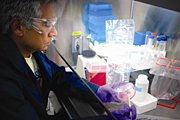- Number 306 |
- March 1, 2010
Probing life’s extremes in Yellowstone

INL biologist Frank Roberto's
research interests include
Yellowstone hot pool viruses,
bison bacteria and mussel
adhesives.
Idaho National Laboratory biologist Frank Roberto squats on a gravelly patch of ground in Yellowstone National Park. At his feet, scalding water churns in a mustard-yellow pool the size of a wheelbarrow. Roberto reaches in with a plastic vial and scoops up a half-cup.
“That’s a good sample,” he says. “We should get something out of this one.”
Every one of Yellowstone’s 10,000 hot springs is a distinct ecosystem, and for two decades Roberto has been trying to figure out how they all work. How, for example, do microbes and viruses survive such extreme conditions (some pools are boiling-hot with the pH of stomach acid)? How do these organisms interact with each other and the landscape?
Roberto and his colleagues have made a series of intriguing discoveries over the years. They’ve found many new virus species, one of which may give scientists a fresh perspective on the origins of life on Earth. And they’ve isolated virus DNA from the vapor wafting off some pools, suggesting viruses are hopping from spring to spring on flying carpets of steam.
On this warm, cloudy day in early August, Roberto is more interested in bacteria than viruses. He’s hoping to collect several different strains of one particular species, with the aim of finding a strain whose DNA he can tweak. He wants to genetically manipulate the microbe into helping with biofuel and bioplastic production.
Many other projects have kept Roberto busy over the years. For example, he has studied the feasibility of using thermal-pool bacteria to separate valuable metals from ore. He helped develop a quick, easy-to-use method to identify brucellosis infections in animals. And Roberto has worked to put mussels’ powerful, waterproof adhesive to work for humans. He has identified several of the mollusks’ key glue proteins and goosed microbes into producing them, a process for which he holds multiple patents with fellow INL biologist Heather Silverman.
Roberto also puts a lot of himself into mentoring students, four of whom are on this Yellowstone trip; DOE’s Office of Science gave him its Outstanding Mentor Award this year. Yet Roberto still finds time to teach aikido and hike, raft and canoe through the wilds of the northern Rockies. He’s a fairly serious climber, too, having summited Wyoming’s steep, craggy Grand Teton.
The research trips to Yellowstone allow Roberto to indulge his passions for science, wildlife and the out-of-doors.
“It’s never the same,” Roberto says, smiling as he watches a big bull bison amble across the steaming earth. “Every time you come out here, there’s some new adventure.”Submitted by DOE's Idaho National Laboratory
